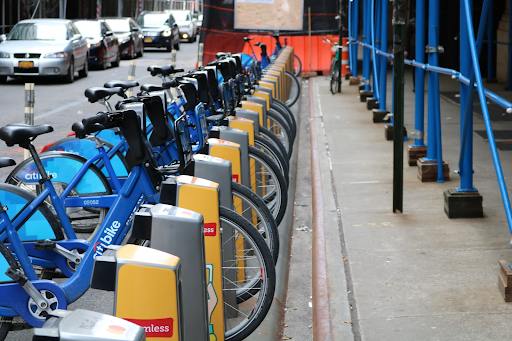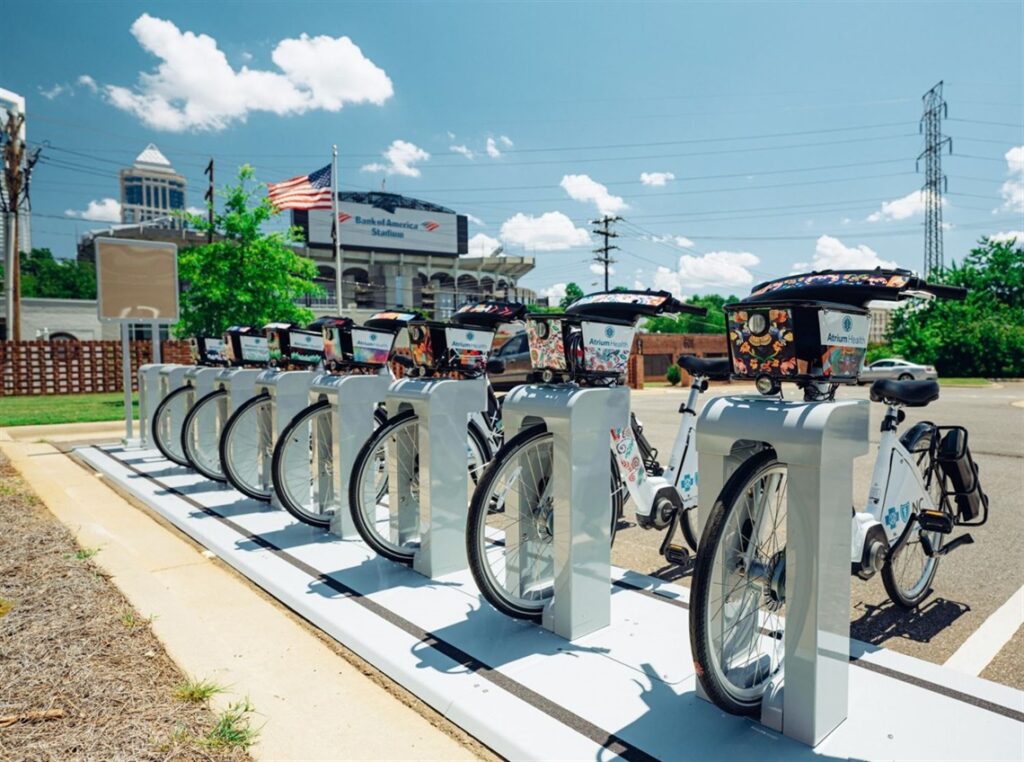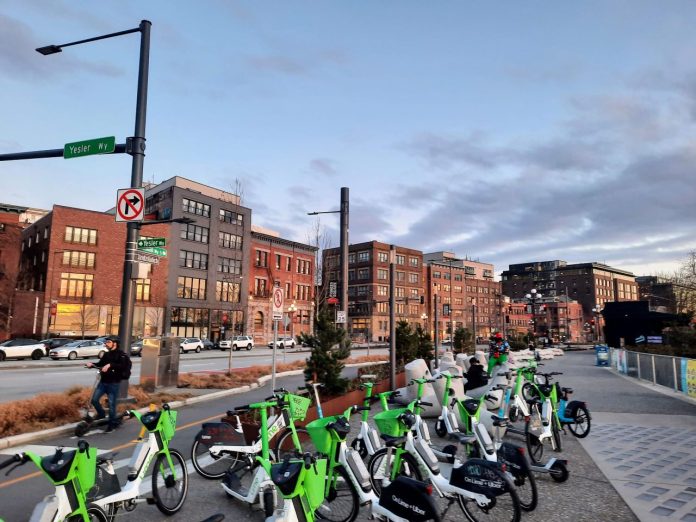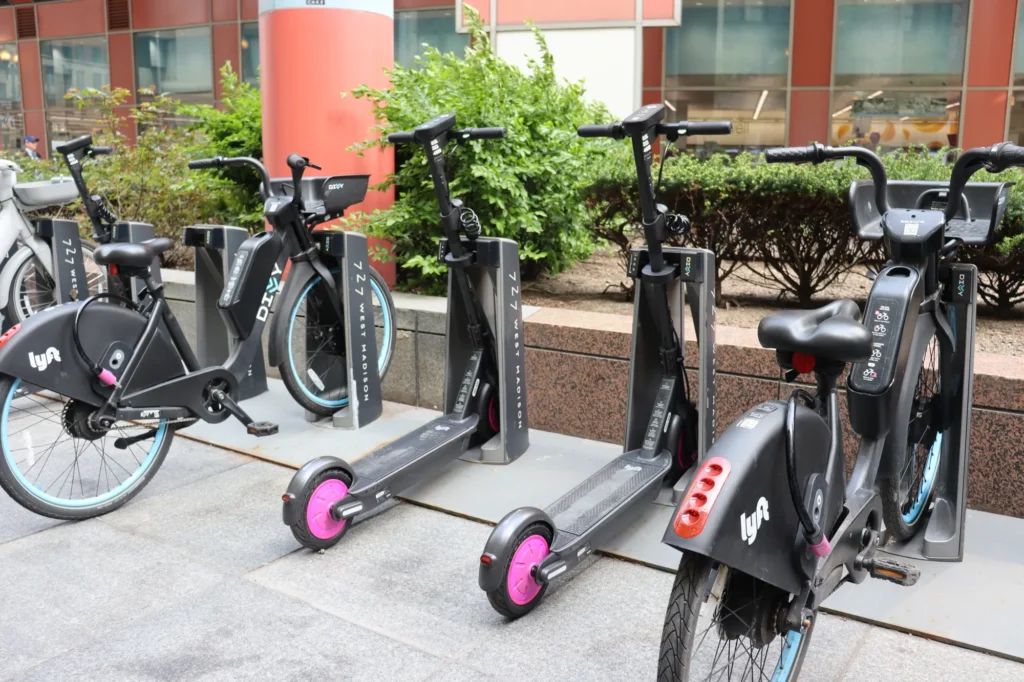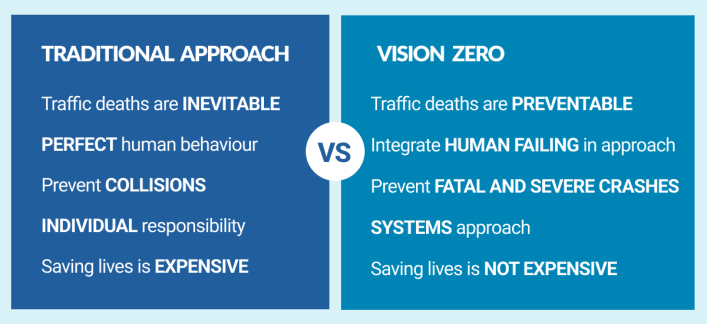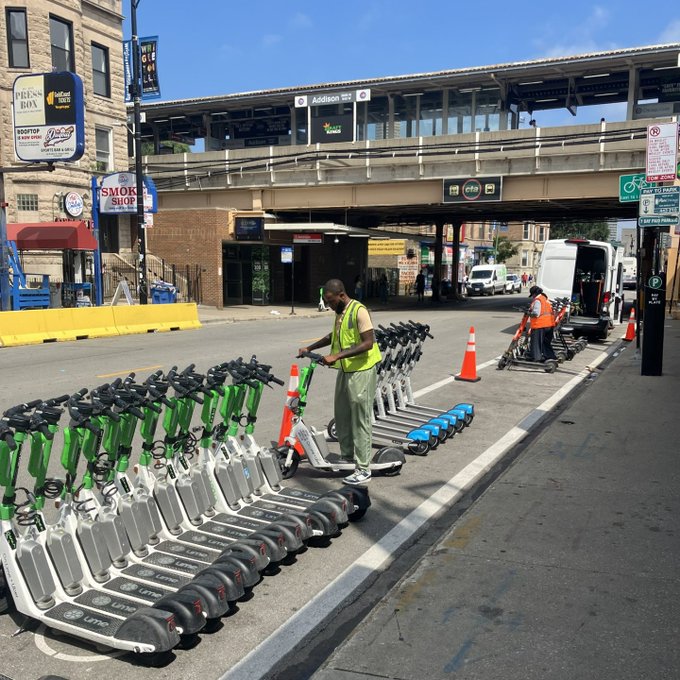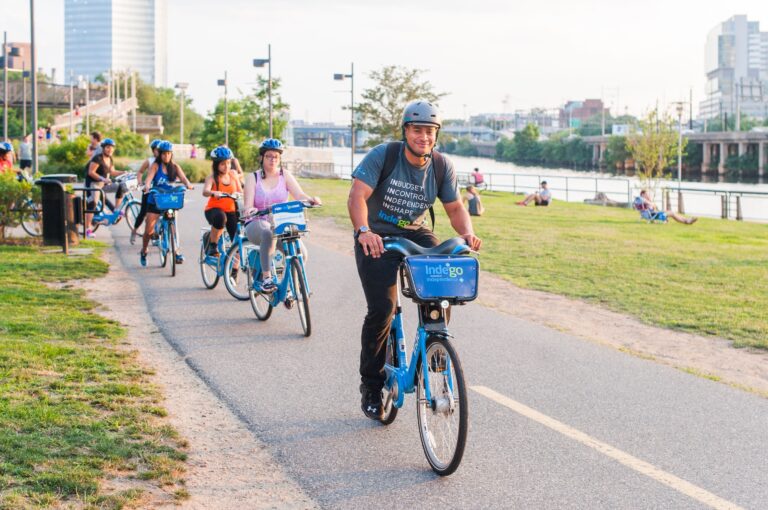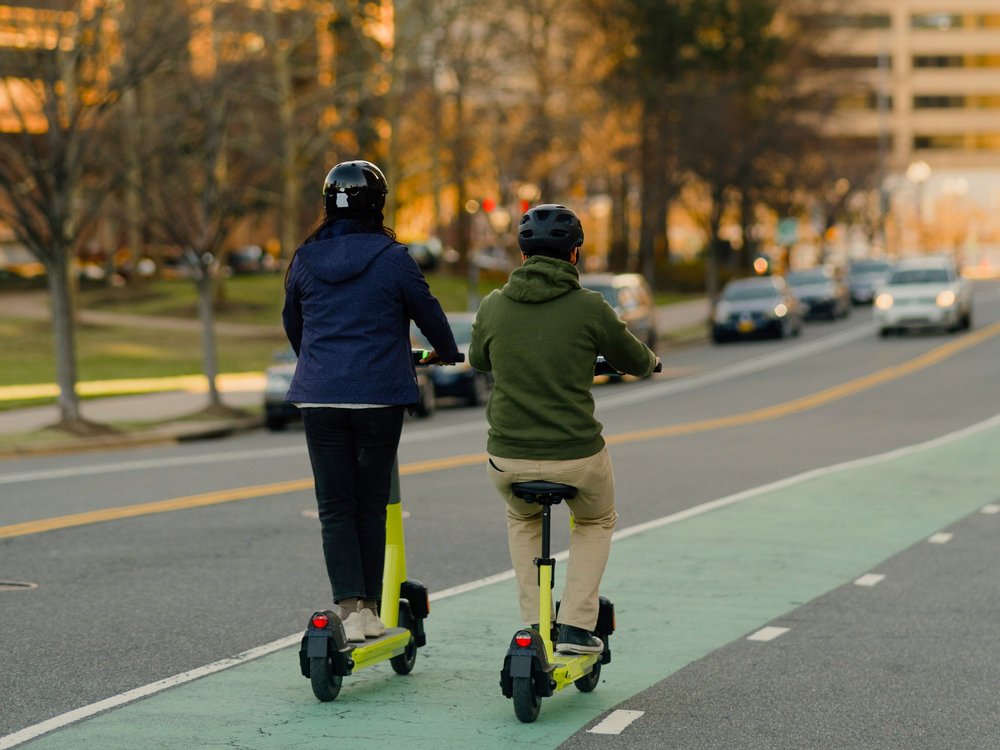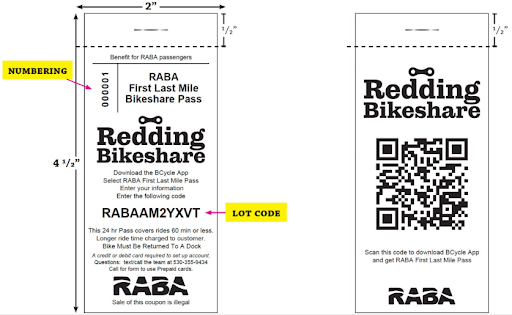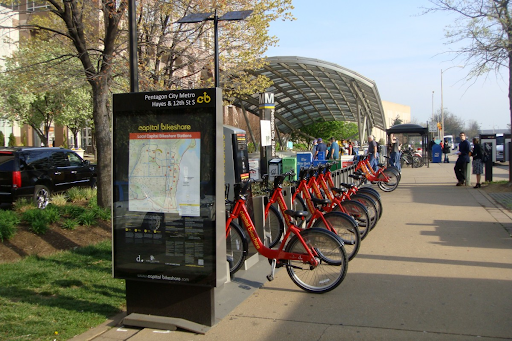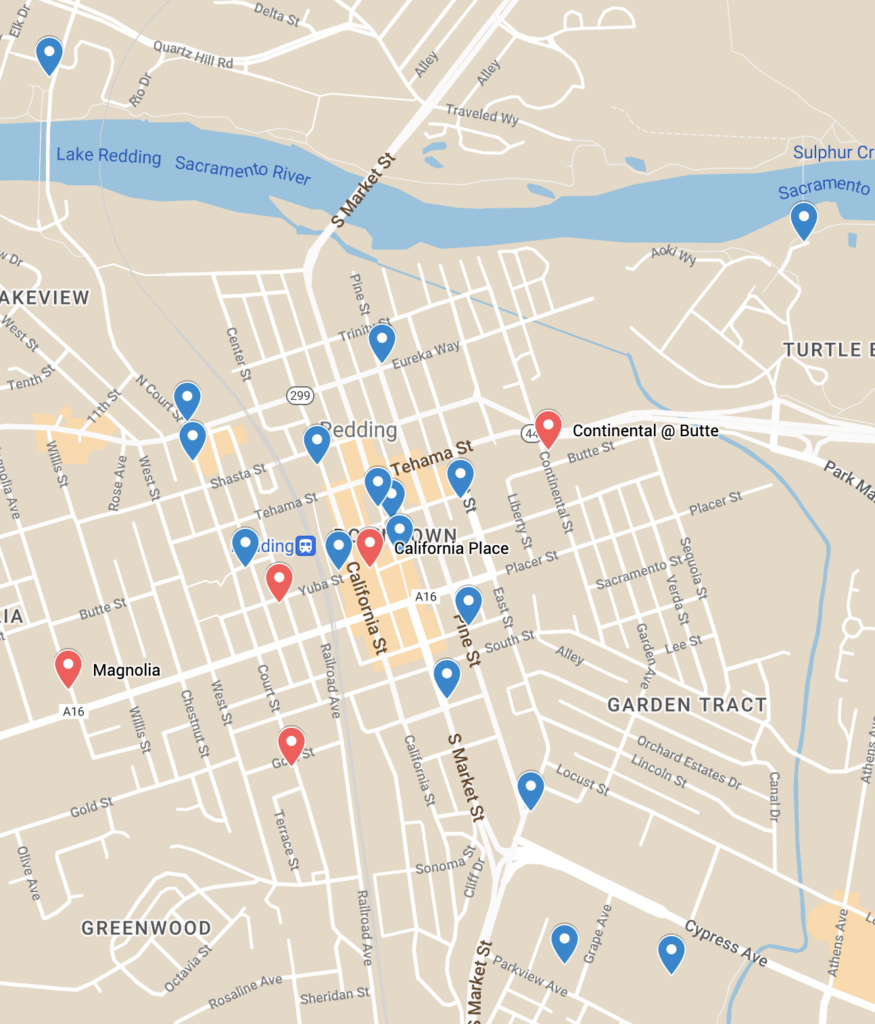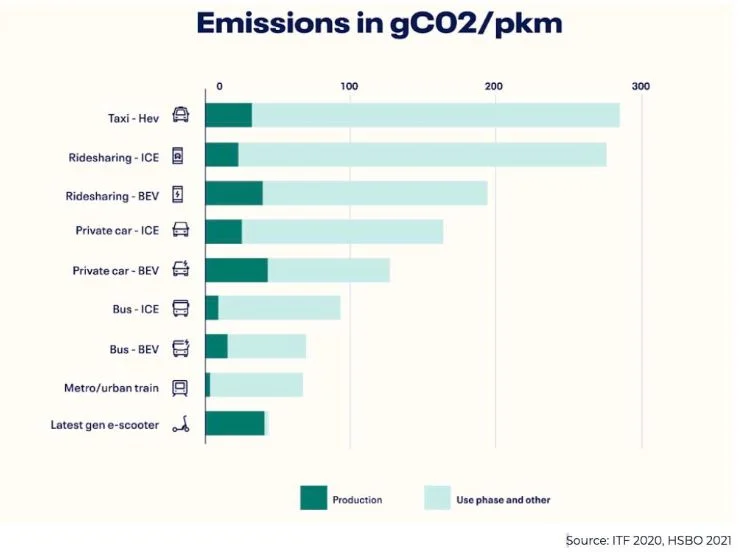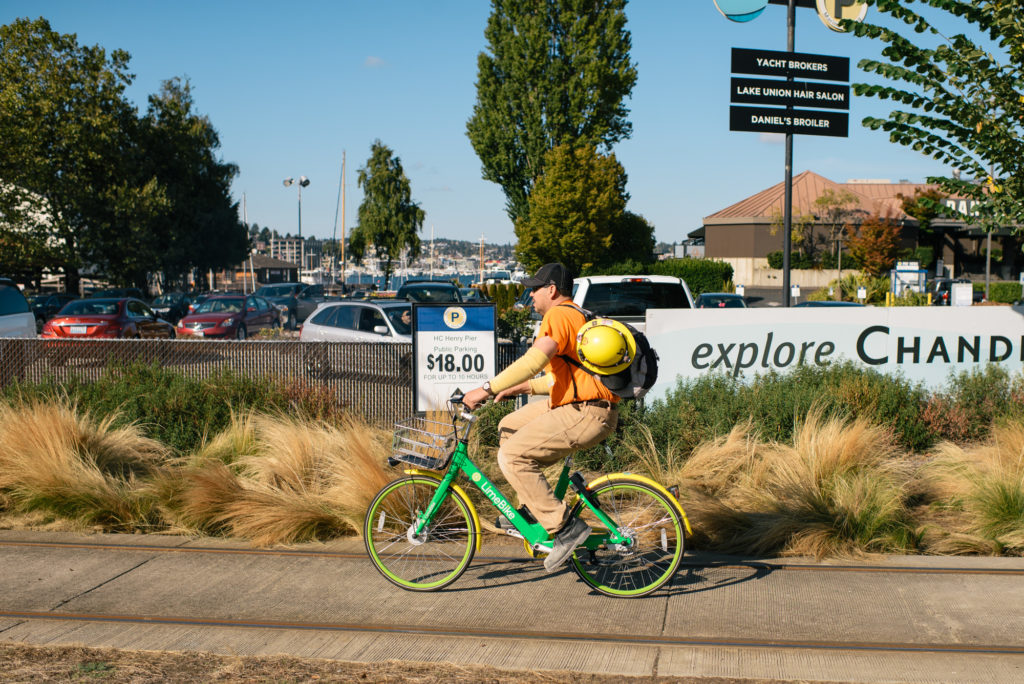Community Engagement
A successful micromobility program requires robust community engagement, starting with the planning process and continuing through operation and possible expansion. Engaging community groups and partners helps build trust, helps reach a target audience, grows awareness of the program, and most importantly, helps understand community need. If the community need is not understood, the project may not be as effective or sustainable as intended. Without aligning the project goals with the actual needs and preferences of the community, the initiative risks low adoption rates, missed opportunities to address equity concerns, and potential resistance from stakeholders and community groups. Community engagement ensures a thorough understanding of community needs, tailoring to local contexts, and delivering tangible benefits. The below case studies are examples of systems that have prioritized community engagement.
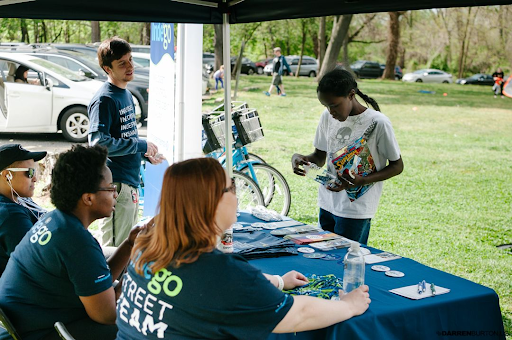
Indego staff at a community outreach event. Credit: Darren Burton Photography
- Indianapolis, IN: Prior to Indianapolis’s 2019 summer expansion of its docked bikeshare system, the city chose to host several community engagement events to inform residents about upcoming services. In neighborhoods that were in the planned expansion areas, engagement events provided food, free helmets, childcare, learn-to-ride classes, and group rides. The goal was to increase awareness before the new bikeshare docks were installed. Importantly, these events were held within the community areas to interact with the community members who would be impacted by the bikeshare expansion, and better acclimate new riders with safe biking procedures.
- Minneapolis, MN: Minneapolis’s Nice Ride bikeshare launched the Nice Ride Neighborhood pilot program as an approach to promote bikeshare in neighborhoods with higher rates of poverty and low bikeshare ridership. The program organized and sponsored events and group rides led by local bicycling clubs offered education on bicycling and traffic rules, and provided unique Nice Ride bicycles to some users to raise interest and promote a sense of community centered on bicycling. This type of community-focused programming is key to fostering equity in bikeshare systems.
- Basalt, CO: WE-cycle, the bikeshare system in Basalt, Colorado, runs “Movimiento en Bici”, a Spanish-language program intended to increase ridership among Latinx residents. The program helps residents sign up for the system, and overcome language barriers related to use; recently, it has also begun offering classes for adults who want to learn (or relearn) to ride.
- New York City, NY: In an effort to increase ridership in Bedford Stuyvesant – a predominantly black community in New York City – Citi Bikes and NYCDOT partnered with the Bedford Stuyvesant Restoration Corporation in 2015. Together, they developed ads featuring Stuyvesant residents who used Citi Bike, and they placed the ads in subway stations, on local buses, and in select newspapers. As a result, bikeshare trips increased by 70% in Bedford Stuyvesant in July 2016 as compared to July 2015, and membership increased 56% from March 2015 to December 2016 (Meyer, 2017). Highlighting locals who use bikeshare – as well as their reason for signing up and explanation of how they utilize the system – can help others view the system as more approachable. The Bedford Stuyvesant Restoration Corporation is also working with other partners to reach out to SNAP participants and public housing residents to increase awareness of bike programming.
- Philadelphia, PA: Philadelphia’s Indego bikeshare system has an ambassador program that manage to create community engagement events and spearhead awareness initiatives. Ambassadors are local residents, and they serve as a trusted resource in their communities. They are also tasked with informing Indego staff when events in their neighborhood are coming up that might benefit from Indego presence, and leading community rides. The Indego Ambassador toolkit is available here. Sometimes Ambassadors are also asked to do a “social media” takeover for the bikeshare system as a whole, making the system feel more personalized and familiar for residents.
Community engagement can also help determine where micromobility can be an effective mode of transportation. In dense urban areas, it serves as a viable mode for shorter trips and can supplement or replace car or public transportation trips. While most micromobility systems operate in dense urban and suburban areas, the worldwide growth of bikeshare as a mode of micromobility has also impacted rural communities. Micromobility options, specifically bikeshare, can serve the same purpose in rural areas as it does in urban areas: providing an alternative to cars while promoting a healthy form of transportation, connecting people to transportation networks or other services, and generally improving the availability of regional mobility options.
Below are examples of bikeshare programs in small urban communities. While these examples are of bike library systems, rural or small urban bikeshare can operate in many different ways just as with large urban bikeshare.
Below are examples of bikeshare programs in small urban communities. While these examples are of bike library systems, rural or small urban bikeshare can operate in many different ways just as with large urban bikeshare.
Both of these examples completed extensive community engagement and strategic planning before implementing their bike libraries to determine the most beneficial locations for the community. As both regions are rural and less dense, deciding on strategic bikeshare locations was crucial to the effectiveness of the micromobility program.
For additional specific examples and suggestions to foster community engagement with mobility projects, see SUMC’s Learning Module on Community Engagement, or view Strategies for Engaging Community: Developing Better Relationships Through Bike Share by the National Association of City Transportation Officials (NACTO).
Next Subsection
Infrastructure Planning
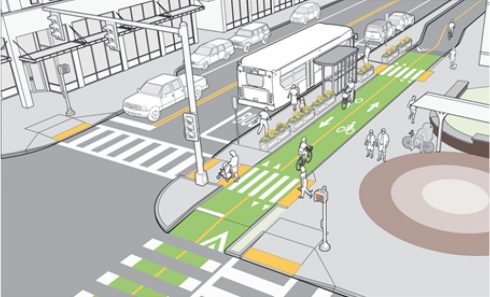
Source: Montgomery Planning; Montgomery County, MD.
The growth and maturity of micromobility operations has provided enough data for best practices for safety and the infrastructure needed for safe operation with other modes of transportation. A study from the Transportation Research and Education Center at Portland State University reviewed infrastructure in several different U.S. cities and gauged the rider’s perception of safety, ultimately finding that riders’ perceptions were closely associated with the type of bike lane buffer. Physical barriers—like planters, curbs, or flexposts—provided a much greater sense of security and comfort compared to painted barriers, leading to increased ridership in areas with this infrastructure. Similarly, a 2019 study on safety in cities with high bicycling rates also suggests that protected bike infrastructure, when combined with higher intersection density and lower-speed environments, results in safer streets for all. These findings emphasize the importance of safe, well-designed infrastructure for micromobility use, and promote integration with public transit. Cities and transit agencies managing micromobility operations have the opportunity to coordinate infrastructure improvements that drive multimodal transit.
A key component of transit integration is expanding transit access through micromobility infrastructure. Transit agencies may create a catchment area (or transit access shed), or the area around a bus or a train station from which a person might reasonably travel. This area may vary depending on geography and mode of transportation. Cyclists, for instance, can typically travel further distances to reach a train or bus service than someone who is walking. Federal Transit Administration (FTA) funds can often be used for bicycle or pedestrian infrastructure that facilitates and improves access to public transportation. While this can include bikeshare docking stations, it is often used to improve bikeway infrastructure leading to and from bus stops or train stations. Investing in such infrastructure improves street safety, making it easier and safer to travel farther to get to a transit facility. These infrastructure improvements serve to increase the catchment areas of the transit facilities and improve the ability of riders to make multimodal connections.
The most visible approach to integrating transit and micromobility is siting bikeshare stations or dockless vehicle corrals near pre-existing transit stops. Colocating micromobility services with transit stops—with docks, stations, or geofenced corrals—ultimately improves the visibility of micromobility services as well as helps public transit users recognize the viability of bikeshare or scootershare as a first and last-mile solution.
Previous Subsection Next Subsection
Infrastructure and Equity
Infrastructure in vulnerable communities can exacerbate mobility challenges. Many lower-income, minority communities are regularly left behind when it comes to protected bike lanes, off-road paths, and traffic calming measures when compared to wealthier, whiter communities. Not only does this cause disproportionately more traffic injuries and deaths in these communities, but it also leads to overpolicing, as riders will often have to bike on sidewalks to avoid unsafe road conditions. In Chicago, IL, bicycle riders in majority-Black neighborhoods received tickets for riding on the sidewalk eight times more often per capita than riders in white neighborhoods. Organizations like Vision Zero are attempting to address these disparities. Below is an example of an effort to help reduce infrastructural barriers to micromobility:
- Oakland, CA: In Oakland, some residents resent micromobility programs as harbingers of gentrification, or unnecessary in light of pot-holed and neglected streets. As a result, when developing its new bike plan to bring the majority of residents within ¼ mile of a safe bike route. Oakland DOT partnered with five local community groups to help facilitate engagement with disadvantaged communities in East and West Oakland, and held 60 community events to gain feedback and comments on their plan. This type of community engagement not only helps to ensure that underprivileged neighborhoods receive the type of mobility service that best suits their needs, but it also helps to increase community trust in and awareness of the bikeshare programs themselves. These 5 community groups are now well-positioned to serve as up-to-date sources of information on new programming opportunities and regulations for their residents.
Previous Subsection Next Subsection
Transit Connectivity
Micromobility systems can enhance public transit connectivity. Research consistently demonstrates that micromobility can complement fixed-route transit services by extending catchment areas and improving first and last-mile transit connection and access. In Aa 2015 study on bikeshare’s influence on mass transit ridership in Washington, DC, researchers found that as bikeshare trips increased, so did Metrorail ridership, suggesting that bikeshare helps facilitate public transit use in general. Tools like Vianova’s whitepaper on fleet size strategies demonstrate guidance for tailoring micromobility solutions to community needs.
The incorporation of existing public transportation is a key element that city officials should consider when planning for new or expanded micromobility systems. Cities like Portland, Oregon have offered a “transportation wallet” which is a bundled transportation pass that includes transit and bikeshare use at a discount versus purchasing the services separately. In addition, the City of West Palm Beach, FL recently approved a bikeshare program, BrightBike, to be fully integrated with the area’s intercity rail system, Brightline. With BrightBike, the city hopes to expand its transit options and help users connect with other transportation methods.
Colocation is particularly relevant for rail or bus rapid transit (BRT) lines. Since these services generally operate directly through major corridors, first and last-mile connections are integral to making these modes effective and convenient. In Omaha, NE, Omaha Metro formalized a partnership with Heartland Bike Share in 2020 while developing the Omaha Rapid Bus Transit (ORBT) service. This partnership helped both entities collaborate on the locations of bikeshare stations to facilitate first and last-mile connections, particularly for people who had to travel long distances to get to an ORBT bus stop. On an even larger scale, agencies can explore mobility hubs as a way to co-locate transportation services. Mobility hubs integrate different mobility options with wayfinding, placemaking, electric vehicle charging, and other amenities to improve a community’s transportation access. From an evaluation of a mobility hub pilot project in Minneapolis, MN, researchers found that the availability of different transportation options significantly impacted travel patterns: 64% of participants surveyed noted that the presence of the mobility hub increased their likelihood of using the available transportation options.
For more information on mobility hubs, see SUMC’s report Mobility Hubs: Where People Go To Move.
Previous Subsection Next Subsection
Regulations
Across the US, cities have taken a variety of different tracks to regulate the deployment and safe use of e-scooters and dockless bikeshare bikes. Some have passed city ordinances that set speed and weight limits for the vehicles and dictate where they are allowed to operate, while others have launched public-right-of-way (PROW) permit programs, where interested operators must apply for permits from the city. These permit requirements often have stipulations regarding minimum and maximum fleet sizes, parking restrictions, data-sharing requirements, and permit or per-vehicle costs. One unique challenge of micromobility relates to speed management. Cities running scooter-sharing or e-bikesharing programs must often determine a maximum operating speed to coincide with safety concerns, region geography, and infrastructure. For instance, most scooter-sharing programs cap the speed at 15-20 miles per hour. Some cities reduce the top speed further through geofencing or disallow riding altogether in certain high-traffic areas like downtowns and shopping districts.
States and cities alike are working to ensure that their active transportation legislation stays up-to-date with emerging technologies and transportation needs. Often, this means passing updated zoning ordinances, formally defining the type of mode offered, and establishing permit requirements. The early regulations for docked operations were largely proactive, which is unsurprising, as most of those systems are city-owned. On the other hand, the regulatory response to dockless operations, which are usually operated via a permit granted to vendors, is often reactive. As a result, much of the focus on dockless bikeshare regulation centers around permit requirements. Dockless bikeshare regulations are also generally more extensive than docked bike regulations. This is due to their more recent appearance as well as their potential to block the public right-of-way. Since the jurisdictions cannot mandate the location of docks, they must figure out ways to geofence their parked locations and maintain an accessible right-of-way. These regulations are unsurprisingly quite extensive, largely due to unique safety concerns associated with the speed of electrified options, and where and how the vehicles themselves are parked. As such, many cities with micromobility programs include provisions in their contracts that prohibit vehicles from blocking sidewalks. For example, Chicago, Illinois required for its scooter-sharing pilot program that all e-scooters be parked in accordance with current bicycle parking regulations, namely out of the way of roads and sidewalks, and further required that vendors be equipped with photographic and geofencing technology to ensure compliance to these laws. These regulations are especially important for the safety of the disability community and compliance with the Americans with Disabilities Act (ADA). In response to a request from the blind community in Charlotte, North Carolina, scooter parking is prohibited in areas adjacent to an Association for the Blind building.
For more information about specific city regulations, visit SUMC’s Micromobility Policy Atlas, which outlines policies and regulations for scooter-sharing programs around the world, including operating rules, equity plans and requirements, data standards, communications, and geofencing guidelines. The Atlas also includes links to original policy and regulatory documents.
Previous Subsection Next Subsection
Procurement
When developing and launching a micromobility program, it is important to identify a partner whose goals and vision align with those of both the community and the transit agency. Having an aligned vision ensures that the partnership supports the microtransit objectives, and fosters long-term sustainability. The following checklist can help.
Before procuring services or equipment, agencies should:
- Work with the community to identify transportation needs and priorities (see Community Engagement Learning Module for community engagement strategies).
- Map out the current transportation services and identify underserved communities. Meaningful community engagement should uncover unmet transportation needs.
- Identify opportunities for micromobility to determine if it is a good fit. Some helpful questions that agencies can ask to guide this process include:
- Are there lower to moderate-density communities that have limited transportation options where fixed-route service is not appropriate?
- Are there communities or neighborhoods that have limited transportation options that micromobility can be used to support access to fixed-route service or key destinations?
- Speak with other cities, transit agencies, and technology vendors to learn how different micromobility solutions have been used. Agencies can ask questions to learn more about service operations, including:
- How has the partnership worked?
- What services does the private partner provide?
- Is there anything that should be changed in the partnership configuration or service model?
- How have they addressed accessibility requirements? What barriers have they encountered along the way?
- Ask questions about the cost of the service and how it is funded, if they are able to discuss.
When ready to procure services or equipment, agencies should:
- Define your Request for Proposal (RFP) and contracting process, identifying who will be involved in developing the RFP and who will be the proposal reviewers.
- Outline the priorities in the RFP and subsequent contract. Some of these priorities could include:
- Data sharing details
- Vehicle fleet and rebalancing details
- Community engagement plans
- Evaluation plans
- Equity plans
- Outline the data needs for the project to adhere to the project goals and performance metrics.
- Consider adaptive vehicles so persons with physical or cognitive disabilities can access the service. Consider how these adaptive micromobility vehicles will fit into the larger fleet.
- Interview vendors during the RFP process and ask for and meet with references to demonstrate they can meet the goals of the project.
Previous Subsection Next Subsection
Funding
Micromobility programs are eligible for various capital and operating costs, most bikeshare programs are funded through a combination of membership fees, tax revenue, and corporate sponsorships. For a program to be successful and financially sustainable, planners should ensure that reliable, long-term funding from corporate sponsorships, or third-party advertising is available. The first step in securing funding is understanding the costs of a micromobility program. There are two types of costs that operators and municipalities encounter – capital and operational.
- Capital costs include the vehicles themselves, alongside docking stations, maintenance equipment, and software. The vehicles can vary in cost depending on the technology included, but are typically relatively low-cost in comparison to bikeshare docks, which can cost $40,000 – $50,000 per station; for example, Portland’s BIKETOWN bikes include a solar-powered LCD screens and chainless shaft drives and cost around $1,500 per bike. Dockless bikeshare systems naturally circumvent the docking station cost, but the bikes themselves require more technology, like on-board GPS and built-in locks, driving up the price. Other capital costs for both docked and dockless vehicles can include the facilities where vehicles are stored and maintained and facilities for operations and support staff.
- Operationally, the largest cost for micromobility systems comes from rebalancing. Rebalancing involves redistributing vehicles among docking stations or dockless vehicles, usually using trucks or vans, so that stations and areas are neither close to capacity nor empty. In addition to presenting large logistical and data challenges, rebalancing accounts for 30%-50% of operating costs. Other significant operating costs include staffing (management, maintenance, customer service, and IT), vehicle maintenance, insurance, and other administrative costs. Docked bikeshare systems must also factor in rebalancing costs, but are generally easier to manage as the bikes are located at stations throughout a city.
While public agencies may face limitations on how they can fund micromobility programs. However, there are a variety of state, local, and federal funding opportunities available for both bikeshare and bike-related infrastructure. Be aware that public funding opportunities are not always guaranteed. Often, micromobility program funding comes from discretionary grants, which are given through a competitive selection process. However, there are also opportunities that agencies can leverage formula grants, which are distributed based on parameters set by Congress. Additionally, agencies have leveraged other public funds to support micromobility programs through intergovernmental partnerships – for instance, partnering with a city, county, or state Parks Department, or through a city’s general budget. Funding for micromobility initiatives typically comes from a mix of public and private sources, depending on the scale and scope of the program, as well as the region’s specific transportation goals.
Public Funding
- The Congestion Mitigation and Air Quality Improvement Program (CMAQ) is administered by the Federal Highway Administration to support transportation projects and related efforts that contribute to air-quality improvements and congestion reduction. Many CMAQ grants have gone to bikeshare projects around the country.
- The Bikeshare Transit Act, which was first introduced in 2019, aims to make some federal transit funds available to bikeshare programs, which would be a huge step in recognizing bikeshare as an important and valid component of a transportation network.
- The Complete Streets Act requires 5% of each state’s federal highway funds to be allocated to complete streets programs to build necessary infrastructure for streets to feel – and be – safer for bicyclists.
Private Funding
- Venture capitalists played a vital role in the development and growth of the micromobility industry. Some of the most recognizable private operators – Bird, Lime, and Spin – disrupted traditional urban transportation by offering convenient and low-cost alternatives to a single occupancy vehicle. Working with local governments and transit agencies helped bridge initial gaps in transportation infrastructure.
- Institutional Investments offer more late-stage funding, especially when compared to venture capitalism. Institutional investors, including pension funds, sovereign wealth funds, private equity firms, and strategic corporate investors, are increasingly participating in the sector, driven by its alignment with global trends like urbanization, sustainability, and technological innovation.
Previous Subsection Next Subsection
Partnership Considerations
During the COVID-19 pandemic, several transit agencies turned to micromobility companies to help fill in transportation gaps caused by the crisis. Many city governments encouraged residents to use micromobility modes like e-scooters in place of crowded public transit, with some cities temporarily banning cars from select streets to make more space for these modes. Other cities, like San Francisco, announced they would ease distribution requirements during the crisis for scooter operators to make it easier to keep the vehicles in operation. The way many public agencies and cities approached micromobility services during the outbreak suggests a growing acknowledgment of the important role such services can play within the larger transportation network and could lead to more public-private partnerships between micromobility companies and transit agencies going forward. Even before the COVID-19 crisis, many cities were taking steps to incorporate micromobility into the suite of mobility options available to residents by developing mobility hubs around transit stations. These hubs, like the ones launched in Minneapolis, MN, San Diego, CA, Columbus, OH, and other large US Cities, feature access to public transit, bike stations, e-scooter parking, and way-finding signage. Specifically, the Pittsburgh Mobility Collective is another promising example of partnerships involving e-scooters; this voluntary collective includes Spin, Zipcar, Masabi, Waze, and Swiftmile, and it aims to find innovative ways to expand and complement access to mass transit services and micromobility in Pittsburgh, PA.
Micromobility programs are contracted in various ways. They can be fully owned and operated by either a government or private entity, or handled through a public-private partnership. In publicly owned, publicly operated programs, the city or transit agency plans and implements all aspects of the program, and owns all of the assets. Since this system is fully run by the public sector, it can more easily prioritize many of the programs’ goals, like equity or integration into the existing transportation network.
Publicly owned and operated: In publicly owned, publicly operated programs, the transit agency or city plans and implements all aspects of the program, and owns all of the assets. Since this system is fully run by the public agency, it can more easily prioritize many of the programs’ goals, like equity or integration into the existing transportation network. For instance, Los Angeles, CA’s Metro Bike Share is both owned and operated by LA Metro.
Privately owned and operated: A city will grant access to public space, but the private companies will handle all implementation and operations, and will also bear the costs. While this setup can be beneficial to the city from a financial perspective, it also makes it more difficult to manage program goals, as there is less direct oversight and the private operators can also be incentivized by profit (although some private bikeshare operators, like Pittsburgh, PA’s POGOH, are non-profit organizations).
Publicly owned and privately operated: These systems have the private bikeshare provider in charge of managing the service, with the city government owning the programs’ assets. In these systems, the city maintains some control, but is less involved in day-to-day operations, and assumes less financial risk. For example, Chicago, IL’s Divvy Bikeshare is owned by the Chicago Department of Transportation, but operated by Lyft.
Previous Subsection
